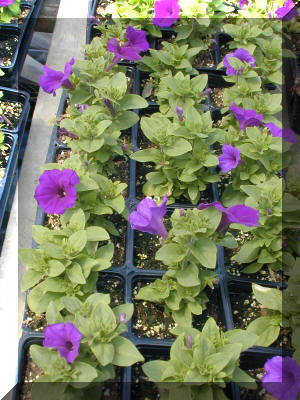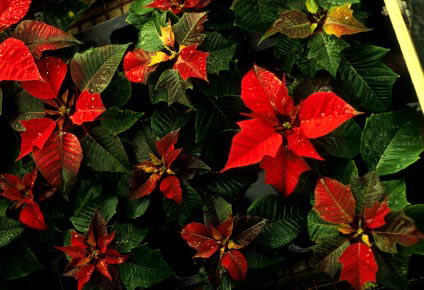 |
 |
 |
 |
GROWTH HORMONES Applications and Alternatives
to use in controling plants height
Prepared by Maher Jabado April 18-2008
 |
 |
 |
 |
The most common growth regulators used in greenhouse crop production are the plant growth retardants. Quality standards dictate that most container-grown greenhouse crops be compact, have short internodes, have a height consistent with the container they are grown in and have strong stems. Although short or dwarf cultivars exist for many greenhouse crop species, chemicals that further reduce plant height and increase the compactness and strength of the plant are often required. Growth regulators may also be used to slow growth or "hold" plant material in the greenhouse.
The growth retardants function by inhibiting
gibberellin synthesis. If gibberellins are
applied to a plant, it will become tall and
spindly. In contrast, if gibberellin production
in the plant is reduced, it will be shorter
and stronger with thicker stems and darker
foliage.
| Damages caused by wrong usage of growth hormones: Plant growth regulators (PGRs) are excellent tools to help control undesirable stretch of floriculture crops. When used at the correct stage of development and rate, they provide excellent height control. Misapplications can lead to catostrophic results, which lower plant quality. Common problems include phytotoxicity, delayed flowering, and stunted growth . This handout is designed to aid in diagnosing the symptoms of PGR overdose Picture on the right side shows damaging effects on the Poinsettia; Typical smaller flower bracts with damages to the leaves |
 |
There are a number of commercial growth retardants used in greenhouse crop production:
B-Nine (also found as Alar) is the commercial name for daminozide. The material is applied only as a foliar spray because it is rapidly broken down when applied to the substrate. It is highly mobile in the plant and will rapidly move from the point of application to all parts of the plant. It is most commonly applied at rates of 1250 to 5000 ppm. B-nine is effective on most crops except pansy, impatiens, geranium and lilies. It is highly effective in controlling growth of seedlings in plug flats, and it is more effective in cooler climates.
B-Nine (daminozide) Phytotoxicity is less of a problem with B-Nine. Because of its lower degree of activity, multiple applications may be required. These multiple applications can cause flower delay or reduced flower stalk elongation if applied too late
Comments:
A late B-Nine application to ranunculus inhibited
the elongation of the flower spike.
Crop delay and a reduction in bract size of poinsettia due to a late season
application of B-Nine + Cycocel.
Cycocel is the commercial name for chlormequat chloride. It is one of the most widely used plant growth regulators in agriculture because it is also used to prevent lodging in grain crops. In greenhouse crops, it is most commonly used on poinsettias, geraniums, azaleas and hibiscus. It is usually applied as a 1000 to 3000 ppm foliar spray. Cycocel is also effective as a substrate drench, but foliar sprays are most common. Foliar Cycocel applications often result in a phytotoxic response (chlorosis), but the symptoms usually disappear after several days. In certain crops (i.e. poinsettia), a mixture of B-nine and Cycocel (at reduced rates) may be used. This usually provides for greater height control and reduces the potential for phytotoxicity.
Comments:
Cycocel (chlormequat chloride) Cycocel. Foliar sprays of Cycocel can cause a yellow spotting or discoloratoin of newly expanding leaves. Damage to the chloroplast causes the yellow spotting and symptoms are evident within 3 to 5 days after application. In general, problems occur when Cycocel rates exceed 1,500 ppm. Expansion of new leaves generally cover damaged leaves within a few weeks.
Typical leaf yellowing caused by Cycocel phytotoxicity of poinsettias. Typical leaf yellowing caused by Cycocel phytotoxicity of geraniums.
A-Rest is the commercial name for ancymidol. It is more effective than either Cycocel or B-nine and is used at much lower rates. Concentrations applied are usually in the range of 10 to 200 ppm for foliar sprays and 0.15 to 0.5 mg per 6-inch container for substrate drenches. A-Rest readily moves through the plant and is usually used on crops where other chemicals are not effective (most notably in bulb crops) or on very high value crops (i.e. plugs). Phytotoxicity may occur from A-Rest application (especially under high temperatures) and usually appears as necrotic spots. Poinsettias are especially sensitive to injury from A-Rest application. The primary limtation for A-Rest is that it is a comparatively expensive growth retardant
Comments:
A-Rest (ancymidol) is safe chemical with limited reports of phytotoxicity.
Phytotoxicity symptoms appear as necrotic spots on leaves of plugs and poinsettias
Problems are more pronounced with high temperatures (>70-90oF, >21-27 C).
Bonzi is the commercial name for paclobutrazol and Sumagic is the commercial name for uniconazole. These chemicals are in the family of growth retardants known as triazoles. These chemicals do not readily move within the plant since they are transported in the xylem. Therefore, triazoles may be absorbed by the leaves, but cannot be transported out of the leaves to other parts of the plant. Because of this fact, it is recommended that when applied as a foliar spray, triazoles should be applied so that the solution contacts the stems. Bonzi is the most widely used growth regulator for horticultural crops and is applied as a foliar spray at the rate of 2 to 90 ppm. Sumagic is applied at a rate of 1 to 50 ppm. The triazole growth retardants are the most persistent (longest lasting effect), and because these materials are active at such low rates, the potential for error and crop damage is much greater.
Height control of Freedom poinsettias with Bonzi foliar sprays.
Comments:
Bonzi (paclobutrazol) and Sumagic (uniconazole) Both Bonzi and Sumagic are triazole type chemicals and have a high degree of activity. Over-application of these chemicals can result in leaf necrosis soon after application, darker green foliage with crinkled leaves, and severely stunted growth . Delay in flowering can also occur.
Begonias are extremely sensitive to Bonzi,
resulting in severe stunting.Cosmos plants sprayed with an excessive
rate of Sumagic (left) and optimal rates on right.
Other Growth Regulators Used In Greenhouse Crops Production
Other growth regulators are used to cause flower bud abscission, increase branching, and promote flowering. These typically function by causing the plant to produce ethylene.
Florel is the commercial name for ethephon phosphonic acid. The material is absorbed by the plant tissue, and due to a change in pH, releases ethylene. Florel is used to promote flower bud abortion and vegetative branching in crops. Although it is used in many situations, it is most commonly used where vegetative cuttings are being produced and in hanging basket production. Florel is applied as a foliar spray at concentrations of 1000 to 4000 ppm. Florel may also be used to promote flowering in bromeliads.
Comments:
Overdoses of Florel are mainly associated with delayed flowering (Figures 17 to 19). Applying Florel to plants under stress (temperature or water) also can result in leaf yellowing.
Florel caused abortion of the flowers, thus
promoting vegetative developmentUneven spray applications of Florel to an
individual plant can result in differences in growth
and flowering.
Application of Growth Retardants
To successfully control the height of greenhouse crops with chemical growth retardants, many factors must be considered:
Crop
Different crops respond differently to growth retardants. Some crops do not respond to certain growth retardants or may respond by different degrees. For each growth retardant and crop, there is an optimal concentration that should be applied. Also, some crops may be more susceptible to phytotoxicity from certain growth retardants than others. For example poinsettias are especially sensitive to A-rest, and application of A-rest to poinsettias will often result in phytotoxicity symptoms. The growth retardant label will list all crops on which the material may be applied.
Stage of Crop
Crops may be more or less sensitive to growth retardants at different growth stages. Crops should have developed sufficient foliage so that the growth retardant may be applied and so that stunting does not occur. Growth retardants should be applied at the correct stage to prevent undesirable effects on growth. For example, late applications of Cycocel or Bonzi to poinsettias can result in reduced bract size.
Concentration
Every crop and growth retardant combination there is an optimal concentration required to achieve the desired results. Concentrations too low will give inadequate height control while concentrations to high will result in stunting or phytotoxicity. Even when the correct concentration is applied, excessive volumes (see Volume of Application) of material can still cause stunting or phytotoxicity. This often occurs when an excessive volume is applied as a foliar spray and the growth regulator runs off into the substrate. In this case the plants receive both a foliar application and a substrate drench treatment.
Method of Application
Some growth retardants can only be applied as a foliar spray while others may also be applied as a substrate drench. When applying a growth retardant as a substrate drench, higher volumes are applied but with less active ingredient per plant. Typically substrate drenches are applied in such a way as to provide a specific amount of active ingredient per container (i.e. 0.25 mg per 6-inch container). This requires that not only the correct concentration of solution be prepared but also that a specific amount of solution be applied per container. Therefore, substrate drenches allow for a more exact amount of chemical to be applied per plant (increasing uniformity) but are more labor intensive than foliar sprays.
Volume of Application
The general rule of thumb is to spray the foliage evenly with the appropriate concentration of solution just to the point of run-off (some run-off will always occur and is assumed in concentration recommendations). With the triazole growth retardants (i.e. Bonzi and Sumagic), the volume must be sufficient to make stem contact. When applied on a large scale, it is assumed that a volume of 2 to 2 ½ quarts of the solution will be applied per 100 ft2 of bench space. In some cases where a dense canopy occurs, 3 quarts of solution per 100ft2 may be required. In cases where high volumes are required to achieve stem contact and uniform coverage, the volume applied may be increased and the concentration decreased.
Coverage and Uniformity
Uniform coverage is essential in order to have uniform growth and crop height. Also, where the triazole growth retardants are concerned, stem contact is required for the growth retardants to be effective.
Environmental Conditions
Under high temperatures most growth retardants become less effective and higher concentrations or additional applications may be required. Also, under high temperatures, the potential for phytotoxicity is increased. Foliar applications of growth retardants are more effective under conditions where drying rate is slower (i.e. low light, high humidity, cool temperatures). This is because the active ingredient is not absorbed after drying, so the longer the foliage remains wet from the spray application, the more active ingredient that is absorbed. The substrate environment impacts the efficacy of substrate growth retardant applications. Composted barks absorb and deactivate growth retardants. Therefore, substrate drench concentrations of growth retardants may need to be adjusted when applied to a substrate containing composted bark.
Example Growth Regulator Calculations
1) Determine the number of ml of Bonzi (paclobutrazol) required per liter for a 10 ppm solution.
Bonzi contains 4000 mg a.i./l or 4 mg a.i./ml
10 ppm = 10 mg/l
therefore, we need to add enough of the Bonzi to have 10 mg a.i. per liter.
1 ml contains 4 mg a.i.
Therefore, 2.5 ml contains 10 mg a.i.
If we add 2.5 ml of Bonzi to 997.5 ml water (final volume of 1 liter) we will have a 10 ppm solution.
2) We need enough 10 ppm Sumagic (uniconazole) solution to cover 1000 ft2 of bench space using the 2 quarts per 100 ft2 rate. Determine the ml of Sumagic required per liter and per gallon for a 10 ppm solution. Then determine the number of quarts required, the total volume of solution required and the total amount of Sumagic required for that volume.
We need 10 mg/L and Sumagic contains 500 mg a.i./L or 0.5 mg a.i./ml
Therefore, 20 ml contains 10 mg a.i. and 20 ml Sumagic added to 980 ml of water (total volume of 1 liter) will provide yield a 10 ppm solution.
There are 3.78 liters/gallon. Therefore, if we needed 10 mg a.i./L, we need 37.8 mg a.i./gallon.
37.8 mg a.i./0.5 mg a.i. per ml = 75.6. Therefore, we need 75.6 ml/gallon.
Or, if we needed 20 ml for a liter, we need 20 ml x 3.78 = 75.6 ml/gallon
There are 4 quarts per gallon. Therefore, we need 75.6 ml & divide; 4 = 18.9 ml/quart.
At 2 quarts per 100 ft2, we would need 20 quarts to cover 1000 ft2. At 18.9 ml/quart. We would need to add 378 ml/20 quarts to cover the required area with a 10 ppm Sumagic solution.
3) You want to apply 0.25 mg a.i. A-Rest (ancymidol) per container and you have 2000 containers. Determine the total volume of solution required and the total amount of A-Rest required.
Some publications recommend applying 3.4 fl. oz. per container while others recommend 8 fl. oz. per container. The goal is to nearly saturate the substrate without having runoff. Remember that you can multiply fl. oz. by 0.03 to convert to liters or 30 to convert to ml.
If we want to apply 100 ml per container, we need a total volume of 100 ml x 2000 = 200,000 ml or 200 liters.
2000 containers x 0.25 mg a.i./container = 500 mg a.i. required
A-Rest = 264 mg a.i./L
Therefore, 500 mg a.i. / 264 mg a.i/L = 1.9 liters
Therefore, add 1.9 liters A-Rest to 198.1 liters of water (total volume of 200 liters) and apply 100 ml per container.
Non-chemical Methods of Height Control
Although chemical growth retardants are commonly used to control height in greenhouse crops, there are non-chemical methods for reducing height, producing more compact crops and "holding" crops. In some situations, non-chemical methods might be the only means available for creating shorter stronger plants or holding crops.
Water StressAllowing plants to dry between irrigation cycles (and suffering mild water stress) reduces plant height and "toughens" the plants. The difficulty is that subjecting the crop to too great of a stress can also result in negative responses such as flower bud abortion, reduced growth and reduced plant quality. Determining how much of a stress to apply and how to apply that stress uniformly is very difficult. However, as a general rule, holding back on water can be used to "toughen" plants and slow growth when material needs to be held.
Nutritional StressIn theory nutritional stress can also be used to control plant growth. The element of choice is usually phosphorus. By limiting phosphorus, internode elongation can be reduced. However, as with using other stresses to control plant height, applying the correct amount of stress without causing undesirable effects can be difficult. In contrast, excessive phosphorus has been shown to increase internode elongation of bedding plant plugs, and therefore excessive phosphorus application should be avoided.
Thigmotropic Responses
Thigmotropic responses are plant responses to physical stresses (i.e. touch). Shaking, rubbing or blowing air across plants has been shown to reduce plant height and reduce internode length. In some cases, rubbing or wind is being used to retard height and "toughen" vegetable transplants. The difficulty with these methods has been how effectively to apply the treatment (i.e. rubbing) over a large crop and how to apply it without damaging the crop.
DIF and DROPA commonly used non-chemical method of height control is temperature control. Holding plants at cooler temperatures reduces growth. However, temperature may be used in a more controlled method to specifically control internode length. This method of height control using temperature is referred to as DIF.
DIF refers to the difference between the day and night temperatures (i.e. difference). The DIF is determined by subtracting the night temperature from the day temperature. A positive DIF occurs when the day temperature is greater than the night temperature. A negative DIF occurs when the night temperature is greater than the day temperature. A zero dif occurs when the temperatures are the same.
Plants grown under a positive DIF are taller than plants grown at a zero DIF, and plants grown under a zero DIF are taller and have longer internodes than plants grown under a negative DIF. As the DIF becomes more negative, plants tend to become shorter. There are some undesirable effects when the DIF is too negative (i.e. chlorosis in lilies). Usually, a -10 DIF has been found to be optimal.
A problem with maintaining temperatures higher at night than in the day is that of heating costs. However, it has been found that the first two hours in the morning is the period of time that DIF is most effective. Therefore, lowering the temperature below the night temperature (creating a negative DIF) for two hours at sunrise is just as effective at reducing plant height and internode length as is maintaining a negative DIF throughout the night.
For more info pls contact:
MAHER JABADO
Woldwide Tels: +31-208908016 and +1-5149561363
Faxes: +31-174890009 OR +31-205241266 OR +1-5142212084